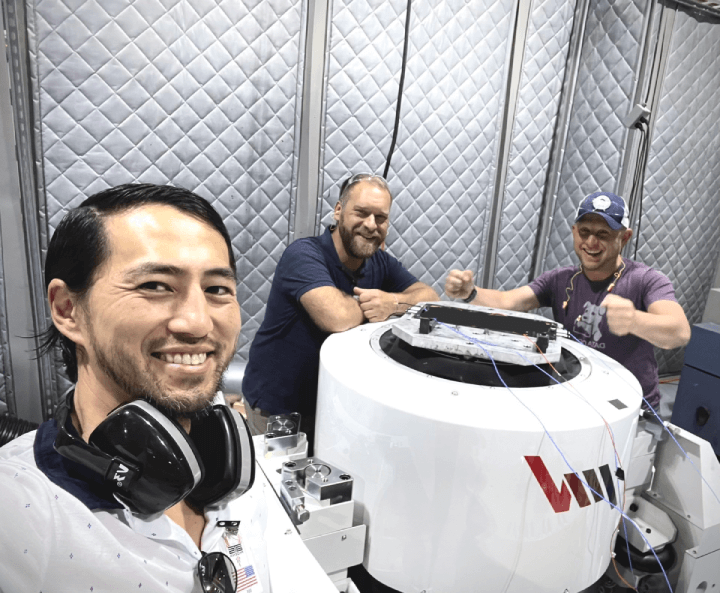Hubble Network Aims to Link a Billion Devices via a Space-Borne Bluetooth Network
14-06-2023 | By Robin Mitchell
Bluetooth is well known for its low energy and short range, making it ideal for sensors and portable hardware, but if someone suggested that Bluetooth devices could stream data to orbiting satellites, most would see such a comment as fantasy. However, for Hubble Network, it plans to launch multiple satellites into orbit that it believes could very well allow for Bluetooth devices to do just this. What challenges do IoT sensors face, what does Hubble Network propose, and is this viable?

The dedicated team at Hubble Network in Seattle working towards a revolutionary global Bluetooth-Satellite connection. Image credit: TechCrunch/Hubble Network.
What challenges do remote IoT sensors face?
Thanks to the falling costs of electronics and improvements in infrastructure, the IoT industry has accelerated massively, with well over 15 billion connected devices across the globe. These devices, which range from complex system controllers to basic sensors, are found in most industries due to their ability to make any system intelligent.
While individual devices themselves will unlikely incorporate intelligent capabilities, the combination of hundreds of sensors producing untold quantities of data in combination with cloud services results in IoT networks being unbelievably powerful. However, for all the advantages that IoT devices introduce, there are numerous challenges that they face, including power consumption, cost, and deployment.
However, for sensors that operate in remote environments (where infrastructure is severely lacking or outright non-existent), by far, the biggest challenge is connectivity. A group of sensors that are placed in close proximity to each other can easily take advantage of mesh networks powered by Bluetooth to provide network access. Additionally, the use of Bluetooth also helps to minimise energy consumption, enabling remote sensors to operate for extended periods on a single battery charge or operate entirely from energy-harvesting power sources (such as solar, wind, and thermal).
But while Bluetooth mesh is great for local networks, trying to get a group of remote IoT sensors to connect to the internet is a whole other feat. With no nearby internet infrastructure, engineers have limited options, with one solution being ideal.
One such solution is to take advantage of LoRa, which can give IoT devices internet connectivity at tens of kilometres of distance. However, a LoRa still requires a receiver that has internet access, and this may not be possible in locations that are extremely remote (hundreds of miles from civilisation).
Another option is to use satellite links, but while these links offer global coverage, the energy needed to operate these networks is far more than what remote IoT devices have available to them. This can be alleviated with the deployment of a router that specifically has its own high-energy power source, but this can require installation and ongoing maintenance, increasing complexity and costs.
Hubble Network to create a global Bluetooth-Satellite connection
Recognising the challenges faced with Bluetooth IoT devices, Hubble Network recently announced that they plan to launch a new satellite service that will allow any Bluetooth device to connect. When considering that Bluetooth is focused on low-energy radio waves, one would be forgiven to think that what Hubble Network is working on is nothing short of complete fantasy, but when looking into the proposal, it could very well work.

John Kim and the Hubble Network engineers with the payload, celebrating their success in the first round of qualification testing. Image credit: TechCrunch/Hubble Network.
The most important feature of the proposed satellite constellation is that the network would be a send-only system and not two-way communication. This means that individual Bluetooth devices will not be able to receive data from the satellites but instead only upload data. By doing so, individual Bluetooth devices do not need to be fitted with a specialised antenna with a great degree of sensitivity. Instead, Bluetooth devices will transmit messages out as normal, and sensitive receivers on orbiting satellites will detect these minute data transmissions.
"That is essentially a huge magnifying glass onto the surface of the earth that’s able to detect these very weak radio signals coming out of the Bluetooth chips, and that’s what enables you to actually decipher and receive the Bluetooth signal." (Source: TechCrunch)
In order to be able to detect Bluetooth signals from space, researchers at Hubble Network have also engineered a number of tricks. Firstly, data rates have been significantly reduced, which helps with improving the signal-to-noise ratio, as a reduced bandwidth offers more time between on and off states (thereby making it easier to recover data). Secondly, satellites will be fitted with hundreds of antennae so that many devices can be connected simultaneously.
According to Hubble Network, their technology and modification to Bluetooth data rates allows for Bluetooth signals to be detected up to 1,000 km, making it perfectly possible for orbiting satellites to receive Bluetooth transmissions from the Earth’s surface. It is hoped that the first four satellites will launch in January 2024, whereby preliminary tests will demonstrate the ability of the satellites to detect Bluetooth signals and reroute the data to cloud servers. If these satellites prove to be practical, the company then hopes to get a constellation of 68 satellites over the next two years.
The technology proposed by Hubble Network is not just a concept on paper. The company has already secured $20 million in Series A funding from investors, including 11.2 Capital, Y Combinator, and others. This funding will be used to launch the first set of satellites in the second quarter of 2024.
"Hubble Network is building the world’s first global network that is easy to use, cost effective, and battery efficient. Our technology operates through a simple software framework, enabling any Bluetooth device to directly connect to our satellite network." (Source: Hubble Network Blog)
Alex Haro, CEO of Hubble Network, believes that their technology will usher in a new era of connectivity. 'Given that there are almost 5 billion devices sold per year with Bluetooth, we have the potential to empower businesses and individuals to unlock unprecedented possibilities in a truly connected world,' Haro said.
"All three of us came together with this vision to connect any off-the-shelf Bluetooth chip directly to a satellite and really enable this network that will work anywhere in the world and be very battery and cost-efficient. We think that will unlock a whole bunch of really cool use cases." (Source: TechCrunch)
Is such a technology viable?
Before we can determine if the technology being proposed is viable, we first need to consider a few factors.
Firstly, there is no doubt that radio technology has massively improved over the past few decades, and the astonishing ability of radio telescopes to be able to detect the faintest signals from lightyears away suggests that detecting a radio emitter from a few hundred kilometres shouldn’t be impossible. Of course, satellite antennae won’t have the same size and capabilities as those used to peer into the cosmos, so their sensitivity will be limited.
Secondly, the atmosphere is able to absorb a lot of different frequencies of electromagnetic radiation, including radio, microwave, and visible light. However, the 2.4GHz used by Bluetooth is mostly transparent to the atmosphere, meaning that signals from Earth should be able to propagate into space. However, at greater distances (such as satellite orbits), a large portion of the Earth is in view, meaning that there are plenty of radio sources that can cause interference. This means that an orbiting satellite will need to be able to selectively pinpoint a source to observe while ignoring all other radio signals.
So, is this technology viable? While there is nothing to suggest that a satellite couldn’t detect Bluetooth signals from space, whether or not such a concept can be rolled out to millions of devices is another story. Considering that the company has received plenty of funding and planning to launch multiple satellites next year, it is more likely than not that the technology does indeed work. All we can do now is wait and see whether a worldwide service is rolled out for future IoT projects.
It's worth noting that Hubble Network's ambitious project has attracted significant financial backing. The company recently closed a $20 million Series A funding round, which will be instrumental in launching its first set of satellites in the second quarter of 2024. This financial milestone not only validates the potential of Hubble Network's technology but also provides the necessary resources to make this vision a reality. The company's leadership team, which includes co-founders with backgrounds in networks, technology, and space hardware, is also a key strength. With such a strong combination of financial support and industry expertise, the future looks promising for Hubble Network's Bluetooth-enabled satellite network.
The company's ambitious plans are backed by a successful $20 million Series A funding round, which will be used to launch its first set of satellites in the second quarter of 2024. The funding round was led by Transpose Platform, with additional participation from 11.2 Capital, Y Combinator, and Yes.VC, Convective Capital, Seraphim Space, Type One Ventures, Soma, AVCF5, Space.VC, Jett McCandless, John Kim, Chris Nguyen, Alan Keating, and Don Dodge. This financial backing and the expertise of the founding team, which includes Alex Haro, Ben Wild, and John Kim, make the future of Hubble Network promising.
According to industry reports, the global IoT market is expected to reach $1.4 trillion by 2027. With its innovative technology, Hubble Network is well-positioned to capitalise on this growth and become a leading player in the IoT space.
Hubble Network's technology has the potential to revolutionise a wide range of industries. For instance, in healthcare, it could enable remote patient monitoring devices to transmit data directly to healthcare providers, improving patient care and outcomes. In agriculture, it could allow farmers to monitor soil conditions in real time, leading to more efficient use of resources and higher crop yields.
"From smart cities and industrial automation to healthcare and agriculture, innovation knows no bounds." (Source: Hubble Network Blog)"
While the technology proposed by Hubble Network is promising, it's important to remember that it's still in the early stages of development. As with any new technology, there will be challenges to overcome and questions to answer. But with its strong team and solid funding, Hubble Network is well-equipped to tackle these challenges and make its vision a reality.
References:
-
Hubble Network. (2023, May 29). Hubble Network Series A. Retrieved from https://hubblenetwork.com/blog/2023/05/29/Hubble-Network-Series-A/
-
Lomas, N. (2023, May 31). Hubble Network is building out a space-based Bluetooth network to connect over billion devices. TechCrunch. Retrieved from https://techcrunch.com/2023/05/31/hubble-network-is-building-out-a-space-based-bluetooth-network-to-connect-over-billion-devices/
-
Crunchbase. (2023). Hubble Network. Retrieved from https://www.crunchbase.com/organization/hubble-network
-
Jewett, R. (2023, June 1). Hubble Network Targets Bluetooth-Enabled Satellite Network with $20M Series A. Via Satellite. Retrieved from https://www.satellitetoday.com/business/2023/06/01/hubble-network-targets-bluetooth-enabled-satellite-network-with-20m-series-a/

